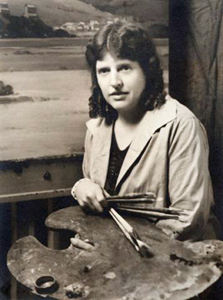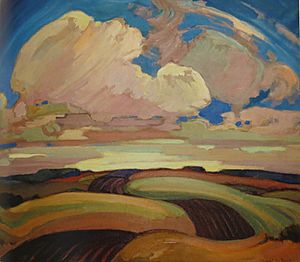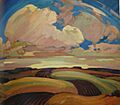Mildred Valley Thornton facts for kids
Quick facts for kids
Mildred Valley Thornton
|
|
|---|---|
 |
|
| Born |
Mildred Valley Stinson
May 7, 1890 Dresden, Ontario, Canada
|
| Died | July 27, 1967 (aged 77) |
| Education | Olivet College, Michigan, Ontario School of Art and Art Institute of Chicago |
| Known for | Painter |
| Movement | Figurative |
| Awards | Fellow of Royal Society of Arts |
Mildred Valley Thornton FRSA (May 7, 1890 – July 27, 1967) was a Canadian artist. She was best known for her colorful portraits of First Nations people. She also painted beautiful landscapes using oil and watercolor paints.
Mildred was born in Ontario, Canada. She moved to Regina in 1913. About 15 years later, she started painting portraits of Indigenous people. She worked very quickly, often finishing a portrait in less than an hour! In 1934, she moved to British Columbia. There, she continued to paint portraits of Indigenous people, collecting almost 300 paintings.
Thornton was a strong supporter of Indigenous and women's rights. She often gave talks while dressed in buckskin. She would even play Indigenous songs she had recorded. She was also a writer and an art critic. She hoped the Canadian government would buy her collection of portraits. When they didn't, she wrote in her will that the paintings should be burned. Luckily, they were saved because of a small mistake in her will. While popular during her life, her work was not well-known for some time after her death. Today, some First Nations people collect her portraits of their ancestors. Others have mixed feelings about her work, seeing it as a form of cultural appropriation.
Contents
Mildred's Early Life (1890–1913)
Mildred Valley Stinson was born on May 7, 1890, near Rutherford, Ontario. She grew up in a big farming family. From a young age, she loved poetry, drawing, and painting. Her uncle, Edward Longman, was a painter and may have inspired her. People described Mildred as "fun-loving, driven, and outgoing."
In 1907, she went to Olivet College in Michigan. Her aunt, Evelyn Beatrice Longman, a famous sculptor, had also studied there. Mildred graduated in 1910. She then lived in Toronto for a few years. During this time, she briefly attended the Ontario School of Art. Her teachers included George Agnew Reid and John William Beatty. She admired the work of Tom Thomson, another Canadian artist.
Years in Saskatchewan (1913–1934)
In 1913, Mildred moved to Regina. There, she saw a First Nations man at a train station. This moment deeply inspired her. She decided then that she would paint Indigenous people. Her interest in Indigenous cultures had started earlier, with the Lenape people of southern Ontario.
Mildred married John Henry Thornton, a businessman, on April 28, 1915. She continued her art studies at the Art Institute of Chicago in 1918–1919. By 1920, Thornton was teaching at the Regina College of Art. Her landscape paintings from this time were very colorful and used bold brushstrokes. In 1926, she visited Canoe Lake in Ontario, where Tom Thomson had died. Later that year, she had twin sons, John Milton and Walter Maitland. Her husband, John, strongly supported her art career. He often took care of their sons when Mildred traveled for her painting.
Thornton began painting First Nations people in 1928. She always paid them for their time. She was truly interested in her subjects and their cultures. At first, people were sometimes suspicious of her. But over time, she found it easier to connect with people. She visited many different tribes, including the Kainai Nation, Cree, Assiniboine, Blackfoot, Piikani Nation, Tsuutʼina Nation, Sioux, Nakoda, and Saulteaux. Sometimes, her portraits were the only pictures ever made of a person. She never sold these Indigenous portraits during her lifetime. She also attended important ceremonies, like the Sun Dance in Alberta. This led her to create paintings about Indigenous myths and history.
In 1930, Thornton helped organize an exhibit of Saskatchewan artists. It was shown at the Canadian National Exhibition in Toronto. The next year, the premier of Saskatchewan, James Thomas Milton Anderson, opened an exhibit of her work. In 1932, she painted a portrait of Arthur Meighen, a former Prime Minister of Canada. In the early 1930s, her art was shown in many important places. These included the Ontario Society of Artists and the Montreal Museum of Fine Arts.
Years in British Columbia (1934–1967)
Because of the Great Depression, John Thornton's restaurant business struggled. So, in 1934, he moved to Vancouver. Mildred and her sons followed him. After a short stay in Toronto, they reunited in Vancouver. John opened a candy store. Mildred quickly organized an art show at the Hudson's Bay Company store in Vancouver. In 1936, she had her own show at the Vancouver Art Gallery.
From Vancouver, she traveled widely. She went as far north as Alaska and east to the Kootenays. She painted among the Haida, Tsimshian, Nisga'a, Gitxsan, Kwakwaka'wakw, Dakelh, Secwepemc, and Salish people. She used any way she could to travel: walking, canoes, horses, steamboats, cars, and trains. She painted people wherever she found them, like at country fairs or the Calgary Stampede. Sometimes, her subjects were close by. For example, in 1946, she painted five Indigenous men in Kitsilano. These included Chiefs Willie Seaweed and Dan Cranmer. They had come to Vancouver for a city celebration. She often brought a slide projector to show her work to people she wanted to paint. One of her most famous portraits was of Agnes Russ, a Haida matriarch.
Thornton recorded important cultural events. These included the potlatch, secret society rituals, whaling, and traditional crafts. Like artist Emily Carr, she visited remote First Nations communities. She painted totem poles, villages, and scenes of daily life. She received at least four honorary names from Indigenous communities. One was "Ah-ou-Mookht," meaning "the one who wears a blanket because she is of noble birth." This name was given to her by Kwakwaka'wakw Chief Charley Nowell.
In the early 1940s, Thornton taught art in Vancouver. In 1944, she helped organize an exhibit called British Columbia at Work at the Vancouver Art Gallery. In the same year, she became an art critic for the Vancouver Sun newspaper. She wrote for them for 15 years. She was part of many cultural groups, including the Canadian Women's Press Club. She also wrote for The Native Voice, an Indigenous newspaper. In the 1940s, Thornton became friends with the Indigenous carver Ellen Neel. Thornton often gave talks about First Nations people and culture. She sometimes wore the buckskin dress of Pauline Johnson, a famous Indigenous writer.
In 1954, she toured Eastern Canada. She showed slides of her paintings and played her recordings of Indigenous songs. Her husband, John, died in 1958. Her son Maitland invited her to London, England, where she stayed until 1961. In 1958, she became a Fellow of the Royal Society of Arts. She gave lectures in London in 1960. In 1961, a major show of her work was held at the Commonwealth Institute. She published her first book, Indian Lives and Legends, in 1966. It combined her portraits with her personal stories.
Thornton loved collecting Indigenous artifacts. People gave them to her, or she bought them. In the early 1960s, her home was full of carvings, masks, small totem poles, and drums. When she had to move to an apartment, her collection was sold to the government for a low price. The British Columbia Archives bought her sound recordings. These recordings have been very valuable since her death.
Since 1946, she had tried to find a museum or institution to keep her collection of First Nations portraits. But all her attempts failed. In June 1967, she added a special note to her will. It said her paintings should either be sold in one big auction or taken to the dump, covered in gasoline, and burned. Luckily, the note was not properly witnessed. This saved the paintings from being destroyed.
Mildred Valley Thornton died on July 27, 1967, in Vancouver, after being ill for several years.
Her Art: Subjects, Methods, and Style
Mildred Valley Thornton mostly painted portraits of older chiefs, artists, and family members of important people. Later, she painted anyone who interested her. Sometimes, she painted children. When making a portrait, she worked quickly. She would start with a charcoal sketch. Her subjects were shown from the side, front, or a three-quarters view. Usually, only their head and shoulders were painted. Their poses looked very natural. For artists, she sometimes included carvings in the background.
She often used whatever materials she could find. Her paintings exist on plywood, Masonite, cardboard, and even old doors! Because she often had less than an hour to finish a portrait, she focused on the face. She would add details to the clothing later. Art experts have noted that Thornton used large brushstrokes. Some people in 1989 thought the simple features of her portraits made them look modern.
Wherever she traveled, she made watercolor sketches of the landscape. These rarely included people. Sometimes, she would later turn these quick sketches into oil paintings. In her watercolors, she liked to use purples, pinks, greens, and blues. Thornton painted totem poles in an impressionist style. She was friends with photographer John Vanderpant. His images inspired her to paint grain elevators in Vancouver. Her finished oil and watercolor paintings were similar to the style of the Group of Seven. They used broad areas of color. Her style is also compared to the Beaver Hall Group and the Emma Lake School.
The first thing people often notice about her paintings is their bright, vivid colors. She often used paint almost straight from the tube. Sometimes, her very bright colors were too much for some viewers. Besides the colors, Thornton's paintings are more realistic than those of Emily Carr, another famous Canadian artist.
Selected Art Shows (Solo)
- Hotel Saskatchewan – Regina, 1930
- Hazen-Twiss store – Regina, 1933
- Little Gallery – Seattle, 1940
- Hudson's Bay Company – Vancouver, 1941, 1958
- Eaton's Fine Art Galleries – Toronto, 1941
- Provincial Museum – Victoria, 1942
- Vancouver Art Gallery – 1936, 1942, 1949
- Commonwealth Institute – London, 1959, 1961
- Gallery of British Columbia Arts – Vancouver, 1980
- Butler Galleries – Vancouver, 1985
- Assiniboia Gallery – Saskatoon, 1989
Selected Art Shows (Group)
- Canadian National Exhibition – 1931, 1932
- Royal Canadian Academy of Arts – 1932, 1934, 1941
- Ontario Society of Artists – 1933
- Art Association of Montreal – 1933
- Vancouver Art Gallery – 1958, 2003, 2006, 2008
- Norman MacKenzie Art Gallery – Regina, 1971
- Simon Fraser University Gallery – 1974
Where Her Art is Kept
- National Gallery of Canada
- McMichael Canadian Art Collection
- Glenbow Museum
- Vancouver Art Gallery
- British Columbia Parliament Buildings
Images for kids



